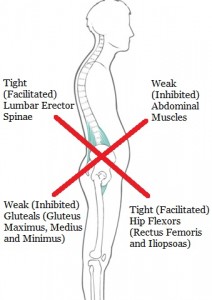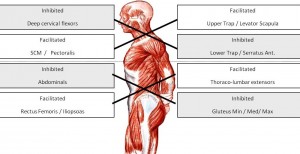The problems caused by sustaining poor posture, especially when sitting at a desk, justify the expression “sitting is the new smoking”
Muscle Imbalance is a common cause of neck, back and shoulder problems.
The notion of muscle imbalance was popularized by a Czech physician by the name of Vladimir Janda. Janda’s patterns of muscle imbalance have been a very helpful paradigm for the management of musculoskeletal problems for decades. Many clinicians use this template to help patients with musculoskeletal problems across numerous disciplines. The general premise is that our bodies have an underlying neurological mechanism known as Sherrington’s law of reciprocal inhibition. This states that when one muscle is on or activated, its antagonist muscle is inhibited. A simple example would be that when you activate your bicep muscle, your tricep muscle turns off or relaxes. This allows you to bend your arm easily. This becomes problematic when we have sustained postures when muscles referred to as tonic muscles are perceived by the body as always being activated.
One of the best examples would be the hip flexor muscle which is constantly shortened in the seated position. The hip flexor rarely gets to full extension as, when we walk, we move from a position of shallow flexion to neutral without really much extension. Similarly, in activities like cycling and skating, the hip flexor is in a shortened position. According to Sherrington’s law of reciprocal inhibition, the shortening of the hip flexor will inhibit the hip extensors. This leads to a pattern where the anterior musculature such as the hip flexor is short and hypertonic, and the hip extensor is long and weak. A similar logic applies to the hip adductor muscles as we tend to sit with our legs together. This leads to the adductor muscles becoming shortened and hypertonic. This inhibits the abductor muscles, especially the gluteus medius. The hip abductor muscle become weak. In my clinical practice, I see a great deal of this so-called crossed pelvis syndrome of muscle imbalance accounting for many difficulties. In particular, the area of hip abductor weakness is a very common perpetuating factor in back pain, hip pain and knee pain. Hip abductor weakness is important in things such as the generation of the risk for ACL tears, by allowing dynamic valgus to develop. Dynamic valgus is where the knee joint drops toward the midline of the body, causing internal rotation of the hip and significant rotational force is applied to the joint.

A similar pattern of muscle imbalance occurs in the upper body as we use our hands and arms ahead of us in postures such as typing on a keyboard or driving a vehicle. The anterior musculature of our upper thorax and neck is “on” or active and becomes tonic and shortened. The posterior musculature affecting our scapulae and the neck extensors become long and weak. This allows a chin forward posture, with the scapulae also moving forward, which leads to rounded shoulders. This provides a platform for the development of many shoulder and neck problems. Simple exercises to retract the scapula and retract the chin, as well as open up the anterior part of the chest should be performed regularly by all people to minimize their risk of musculoskeletal problems affecting the shoulder and neck.

In general, I emphasize that people should not perform exercises that enhance their areas of muscle imbalance. For example, things like sit-ups worsen the muscle imbalance that affects the pelvis as well as that the affects the shoulder. Exercises that enhance good posture such as push-ups, planks and Brugger exercises are very helpful. Paying attention to muscle imbalance in the workplace and in the gym is very important for your musculoskeletal health.
Sitting is the new smoking…
